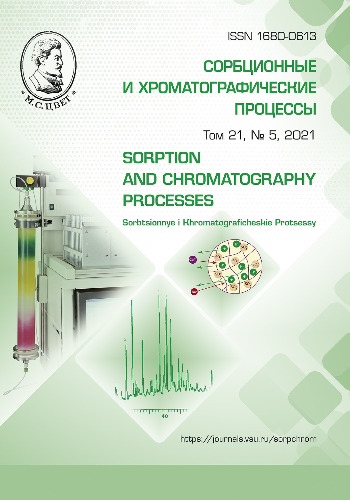Sorption and thermodynamic characteristics of aluminium electrodes modified with europium over a wide temperature range
Abstract
This paper studies the effect of temperature on the hydrogen sorption by an aluminium alloy doped with europium. The aluminium electrodes were modified using cathodic incorporation. At first, europium was incorporated from a 0.5 mol dimethylformamide (DMF) solution of europium salicylate with a cathodic polarisation potential of -2.9 V (relative to non-aqueous silver chloride electrode) at 25°C. Then hydrogen from an aqueous-organic electrolyte (dimethylformamide and water, in a ratio of 7:3) was introduced to the prepared aluminium-europium electrode at the following temperatures: 253.15; 263.15; 273.15; 283.15; 293.15; 303.15; 313.15; and 323.15 K. During the experiment, we used potentiostatic curves to calculate the diffusion-kinetic characteristics of hydrogen sorption during electrolysis, such as the incorporation constant, the concentration of atoms incorporated in the matrix, the diffusion coefficient, and the adsorption value. We also determined the effect of the cathodic incorporation temperature on the nucleation process and thermodynamic characteristics of the obtained electrodes. We used the electromotive force method to determine the thermodynamic properties: Gibbs free energy (∆G), entropy (∆S), enthalpy (∆H), and activation energy. The study showed that an increase in the temperature results in an increase in ∆G, ∆S, and ∆H, which means that at higher temperatures the degree of system disorder increases. An analysis of the potentiostatic curves in various coordinates demonstrated that the hydrogen diffusion process is accompanied by the parallel growth of the hydride layer, which occurs due to the chemical interaction between hydrogen and the elements of the Al-Sm alloy.
Downloads
References
Wang J., Li G., Fu K., Li X., Journal of Materials Science, 2019, Vol. 54, No 20, pp 13334-13343. DOI: https://10.1007/s10853-019-03608-3
Hosono H., Kitano M., Chemical Re-views, 2021, Vol. 121, No 5, pp. 3121-3185. DOI: https://10.1021/acs.chemrev.0c01071
Prigent J., Joubert J.M., Latroche M., International Journal of Hydrogen Energy, 2017, Vol. 42, No 35, pp. 22348-22352. DOI: https://10.1016/j.ijhydene.2017.01.002
Hirscher M., Yartys V.A., Baricco M., von Colbe J.B. et al., Journal of Alloys and Compounds, 2020, No 827, pp. 153548. doi: https://10.1016/j.jallcom.2019.153548
Yong H., Guo S., Yuan Z., Qi Y., Zhao D. et al., International Journal of Hydrogen Energy, 2019, Vol. 44, No 31, pp.16765-16776. DOI: https://10.1016/j.ijhydene.2019.04.281
Huot J., Cuevas F., Deledda S., Edalati K. et al., Materials, 2019, Vol. 12, No 17, pp. 2778. DOI: https://10.3390/ma12172778
Percheron-Guegan A., Lartigue C., Achard J.C., Journal of the Less common Metals, 1985, Vol. 109, No 2, pp. 287-309. DOI: https://10.1016/0022-5088(85)90061-X
Luo Q., Li J., Li B., Liu B. et al., Jour-nal of Magnesium and Alloys, 2019, Vol. 7, No 1, pp. 58-71. DOI: https://10.1016/j.jma.2018.12.001
Vargas S.J., Schaeffer N., Souza J.C., da Silva L.H. et al., Waste Manage-ment, 2021, Vol. 125, pp.154-162. DOI: https://10.1016/j.wasman.2021.02.038
Zhang S., Saji S.E., Yin Z., Zhang H. et al., Advanced Materials, 2021, Vol. 33, No 16, pp. 2005988. DOI: https://10.1002/adma.202005988
Hadjixenophontos E., Dematteis E.M., Berti N., Wołczyk A.R. et al., Inorganics, 2020, Vol. 8, No 3, pp.17. DOI: https://10.3390/inorganics8030017
Fu K., Li G., Li J., Liu Y. et al., Jour-nal of Alloys and Compounds, 2017, No 696, pp.60-66. DOI: https://10.1016/j.jallcom.2016.11.182
Gots I.Y., Lukyanova V.O., Perspek-tivnye materialy, 2020, No 2, pp. 39-47 DOI: https://10.30791/1028-978X-2020-2-39-47
Olshanskaja L.N., Danilova E.A., Kircheva A.A., Vіsnik Harkіvs'kogo nacіonal'nogo avtomobіl'no-dorozhn'ogo unіversitetu, 2011, No 52, pp. 91-96.
Gavrilova N.V., Kudrjash V.I., Litejnov Ju.V., Harchenko E.L. et al., Mezhdunarodnyj nauchnyj zhurnal Al'terna-tivnaja jenergetika i jekologija, 2008, No 8, pp. 10-26.
Gots I.Y., Klimov A.S., Madzhulo A.S., Nechaev G.G., Vestnik Saratovskogo gosudarstvennogo tehnicheskogo universi-teta, 2012, Vol. 3, No 1, pp. 67-72.
Olshanskaja L.N., Popova S.S., Za-kirova S.M., Electrokhimia, 2000, Vol. 36, No 8, pp. 951-958.
Olshanskaja L.N., Terina E.M., Nichvolodin A.G., Electrokhimicheskaya energetika, 2001, Vol. 1, No 4, pp. 49-53.
Popova S.S., Celujkina G.V., Kabanov B.N., Electrokhimia, 1985, Vol. 21, No 2, pp.161-167.
Popova S.S., Fazy vnedrenija v jel-ektrohimii i jelektrohimicheskoj tehnologii. Saratov, Izd-vo Sarat. gos. tehn. un-ta, 1993,78 p.
Lukyanova V.O., Gots I.Y., Con-densed Matter and Interphases, 2020, Vol. 22, No 4, pp. 481-488. DOI: https://10.17308/kcmf.2020.22/3118







